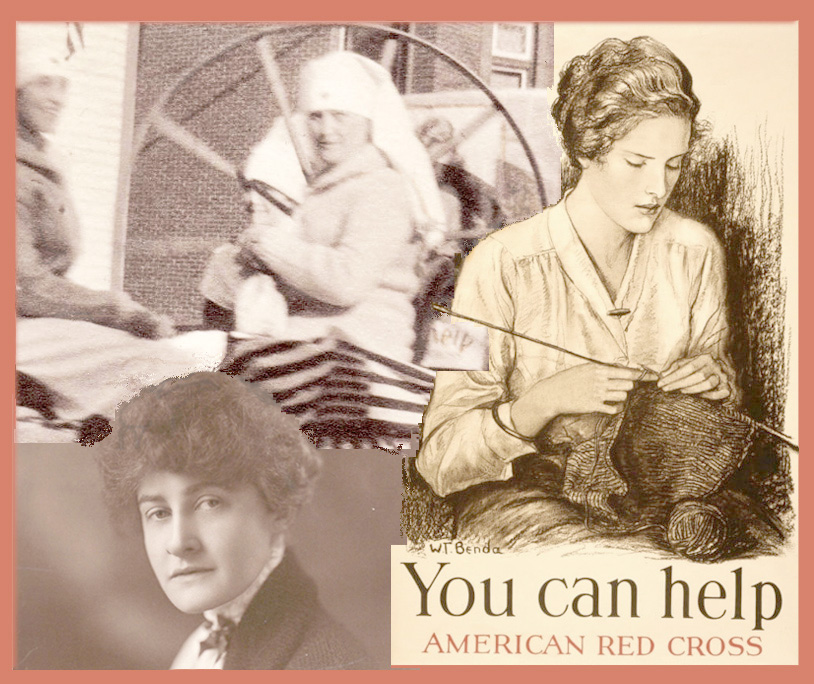When I ran across this old photo of a float in a World War I Veterans Day parade in Waynesburg for last month’s issue, some of the details puzzled me. I wrote, “I look at the big wheel mounted in front of the poster. What was the meaning of this?” And what exactly was on the poster behind the woman? It was hard for me to tell with shadows from the wheel hiding what might be a face or a logo. Or both. Who knows?
Thanks to John Cole of Waynesburg and Greene Connections, I’ve now been able to create a collage that helps bring this blast from the past back into sharper focus.
Cole was waiting for me when I arrived at Waynesburg Senior Citizens Center a few mornings after the Greene Scene arrived in his mailbox. We were both there to deliver Meals on Wheels but John had something special for me—and for those of us who, like me, have puzzled over these fuzzy details.
“It’s a spinning wheel!” He told me as he opened up his copy of the story with my questions circled. “She’s spinning. And look! You can see the needles on the poster behind her. I looked it up online.” John unfolded another sheet of paper to show me the poster that he’d printed out in black and white. It was the serene face of a woman, gazing down at her knitting. This was the iconic poster that would lead the nationwide charge for the women—and everyone else—of America to get busy knitting hats, socks, gloves, sweaters, washcloths and anything else warm and useful they could ply their needles to during the war years of 1917-1918. There was a great need for socks as winter approached and soldiers were stationed in wet muddy trenches on the front lines of “the war to end all wars”.
Together we peered at the old photo that I’d shared last month, focusing on the partial image of the poster visible behind the spinning wheel. Now I could see the hairline and suddenly the random tones transformed into the woman’s face. Below the darkness of the knitting was the faded word “help” just as the larger poster spells out “You can help.” and below that “American Red Cross.” We had a match.
“I love looking at old photos,” Cole admitted. “I was reading your article and started looking hard and said, ‘Hey, that’s an old spinning wheel!’ They were ‘Knitting for Victory’ for the Red Cross. There’s a lot of information about it on the web.”
Cole opened another sheet with information he’d copied from his browser. “The poster was done by Wladyslaw T. Benda. He was a Polish immigrant commissioned to do the art. And look at the shadows in the photo. You can tell the sun’s low in the sky, and there are no leaves on the trees. I’d say late fall. Everybody was knitting in 1917: school kids, doctors, everybody. The Salvation Army had a big push on. They’d send patterns, and people would knit.”
It would be a few more minutes before either of us remembered we were there to deliver meals.
Later at home, I texted Candice Lynn Buchannan, our local historian who now works at the Library of Congress, about how wonderful it was to have John Cole help identify the almost lost details of the old photo I’d found in Greene Connections.
“I’m glad you found a photo using our subject index. I hope you find more!” she texted back. “We are working on an individual name index. There are lovely photos of Nella in better focus, if you want a better look at her. Here’s a shortcut: https://hub.catalogit.app/4150/search/%22hoskinson%20nella%20sophia%22
The parade photo is a unique candid for many reasons.”
Indeed, it is; shot off the cuff and out of focus, it is part of the Nella (Hoskinson) Baily collection, sandwiched in with a handful of other more formal family photos that exemplify the social coda of the late 19th and early 20th centuries.
Clicking on the link Candice sent me, I found myself caught up in that other time, filled with images of Nella posing with her family as an infant, small child, older sister, loving niece, young debutante and even a college athlete looking over her shoulder in a swimsuit. Then later, as a grown woman, there’s even a shot of her and her husband Ralford Baily. Freed from the post-Edwardian posturings, they’re caught standing on the street together, stoic adults of the mid 1920s.
I chose this shot of Nella because it is closest to the age she would have been in the World War I era photograph on the float. It’s fitting to see her in full focus looking back at us, her eyes telling us she remembers all the other details of that day we’ll never know.
